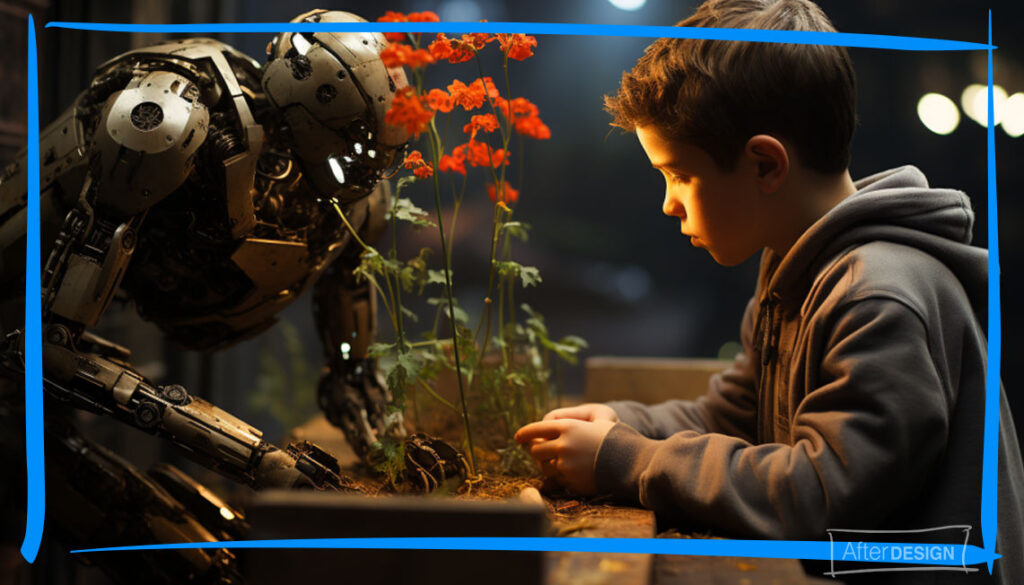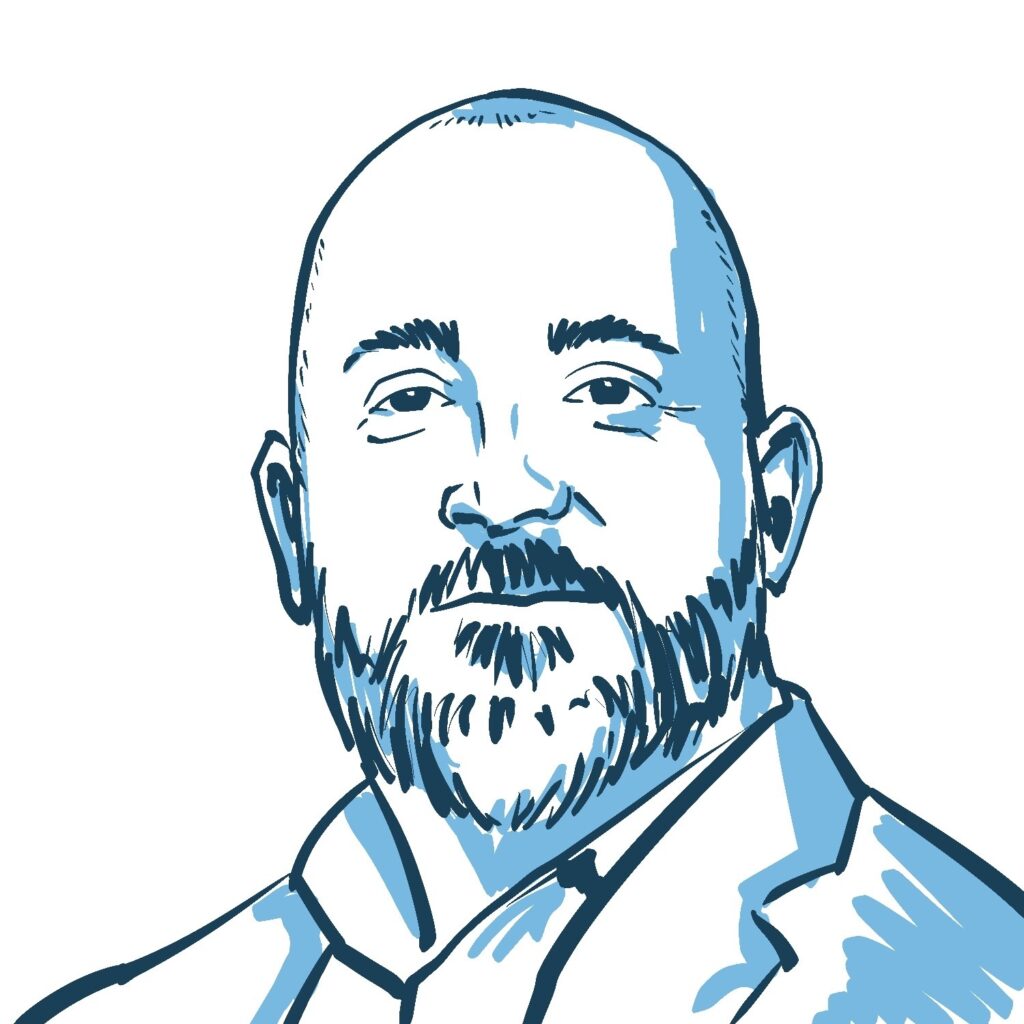I watched an interesting video on Threads earlier this week from designer and YouTuber, Fuller Moehagen. In the video, he gives his thoughts on a recent Fortune article that talked about AI’s impact on graphic design.
Fuller says you don’t have to be “team AI is bad” or “team AI is good.” It’s simply happening.
At this point, AI is like gravity. You can try to thwart it for a little while, but at the end, gravity always wins. It just is.
AI is here and it’s only getting smarter.
In July 2022, in the RISE community, marketing expert Mark Schaefer said designers are worried due to Dall-E 2’s ability to create images. I was dismissive at first, but then I started to do some research and understand what was actually starting. We both agreed that writing was going to be impacted, too.
And then in November 2022, ChatGPT was introduced and AI moved from the enterprise to the consumer. It’s hard to believe it’s only been a year since AI became the dominant topic in many conversations.
I attended a few marketing events this year, and I’m glad we’re not playing a drinking game where we have to drink every time someone says “AI.”
The key thing Fuller – and many others – have said is that you probably won’t be replaced by AI, but you could be replaced by someone who knows how to use AI.
Are you running tests? Have you created your own GPT (more on that in a minute)? Are you active in communities that are exploring these emerging areas?
What are you doing to avoid being left behind? Hit reply (or comment below) if you’re trying to figure it out or want to know where to start.
News at the Intersection of AI and Design
🗑️ To the Endless Stream of A.I. Junk: Thank You and Uh Oh
In a world inundated with low-effort, subpar AI-generated content, Jay Acunzo’s article serves as both a grateful acknowledgment and a stern warning.
- Gratitude for Mediocrity: The article starts with a somewhat ironic thank you to those who flood the market with mediocre AI-generated content. This “endless stream of junk” ironically helps those who focus on quality, integrity, and creativity to stand out more easily in a world of sameness.
- Concern for Creative Integrity: The second half shifts to a more serious tone, expressing concerns about the devaluation of creatives’ work due to the misuse of AI tools. The author calls for a balanced approach that respects and pays creators fairly, and for companies to align their actions with their proclaimed values for principled AI use.
🤑 AI investment forecast to approach $200 billion globally by 2025
Goldman Sachs predicts a major investment surge in AI, forecasting it to approach a staggering $200 billion globally by 2025.
- Rapid Growth & Potential: AI investment is expected to skyrocket, with potential impacts on GDP similar to historical booms in electricity and personal computing. This growth is driven by investments in various sectors, including those developing AI models, supplying infrastructure, and creating AI-enabled software.
- Early Adoption & Long-Term Impact: The U.S. leads in AI technology, and its companies are likely to be early adopters. Although AI’s productivity effects might take time to manifest, significant AI adoption across industries is anticipated between 2025 and 2030.
👨🏻🎨 Pros and Cons of Using AI Tools in Graphic Design
Posta Studio explores the impacts of AI in graphic design, weighing its advantages and drawbacks. Here’s a condensed look at their insights:
- Pros – Efficiency, Consistency, and Creativity: AI tools in graphic design offer speed and efficiency in tasks like image editing, ensure consistent branding across materials, and spark creativity with unique design ideas. They also present a cost-effective alternative for startups and small businesses.
- Cons – Lack of Human Touch and Originality: However, AI tools may miss the human touch and emotional intelligence, often rely on templates limiting originality, and pose a learning curve for integration. There’s also a risk of designers becoming overly dependent on AI, hindering their creative growth.
For a comprehensive understanding of how AI tools can reshape the graphic design landscape, keep reading.
Also, I’m skipping the Humane AI Pin. It’s buzzy, but it feels like the next version of Google Glass. It seems a product that is more of a “look what we can do” rather than a “people asked for this.”
New Resources for you

Every now and then I want to reset the table. Some of you might be 20+ issues into this newsletter, and for others, this is your first issue. With that in mind, here’s a way to think about using AI to help with creativity.
Looking to boost creativity with AI?
In a world where creativity intersects increasingly with technology, AI-assisted tools are redefining the landscape of various creative fields, from art and design to music and advertising. Here’s a deeper look into this transformative synergy:
- Enhancing Creativity Across Industries: AI tools are revolutionizing creativity in numerous sectors. They enable problem-solving and innovative thinking by augmenting human intelligence with machine learning and algorithmic capabilities. This blend of AI and creativity is particularly powerful in fields where innovation is key.
- AI’s Role in Creative Expansion: Far from replacing human creativity, AI acts as a catalyst that amplifies it. By analyzing and learning from vast data sets, AI can generate novel ideas and perspectives, thus expanding the creative possibilities beyond the traditional human scope. This synergy of AI and human creativity is seen as a loop of perpetual learning, leading to enhanced creative outputs.
- Practical Applications and Case Studies: Real-world applications of AI in creativity are numerous and impactful. Platforms like Pinterest have used AI to enhance user experience and creativity, while in the music industry, AI tools like Amper Music aid artists in composing music. These examples demonstrate that AI, instead of stifling human creativity, actually broadens it by handling repetitive tasks and adding speed and scale to the creative process.
- Maximizing AI for Creative Processes: To fully leverage AI in creativity, it’s vital to understand the compatibility between the creative needs and the capabilities of AI tools. Integrating AI tools into the creative workflow can be highly effective, but it’s crucial to maintain a balance to avoid over-dependence on AI, thereby preserving the unique human touch in creative outputs.
AI-assisted tools, therefore, offer a compelling avenue for creative professionals to explore new horizons and elevate their creative processes. Just like any other tool, if you know what these tools are capable of doing, you’ll know when to use which tool.
I made an After Design GPT! I fed it a few dozen articles and newsletters that I’ve written on the topic of AI and Design. There are times when it hallucinates more than my old college roommate, but it’s been an interesting excerise to understand how to create these. Try it out and let me know what you think!

If you want to see what else is out there, Brian Piper recently found this site: https://customgptslist.com/
For those who didn’t get the reference in last week’s newsletter subject line, I was referring to the X-Men villain, Master Mold. Master Mold is a giant Sentinel factory that creates more Sentinels.
How can I help you?
If you want to learn more about what’s available, here are some links:
Thanks for reading!
-Jim
Want to join hundreds of other designers who are staying ahead of the coming AI wave?
Subscribe now to get the latest in AI and Design in your inbox each week.



